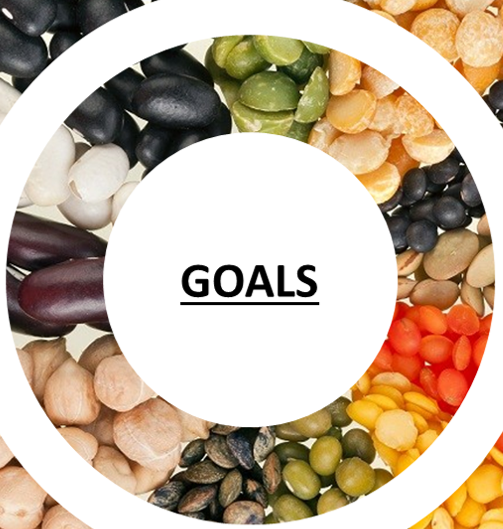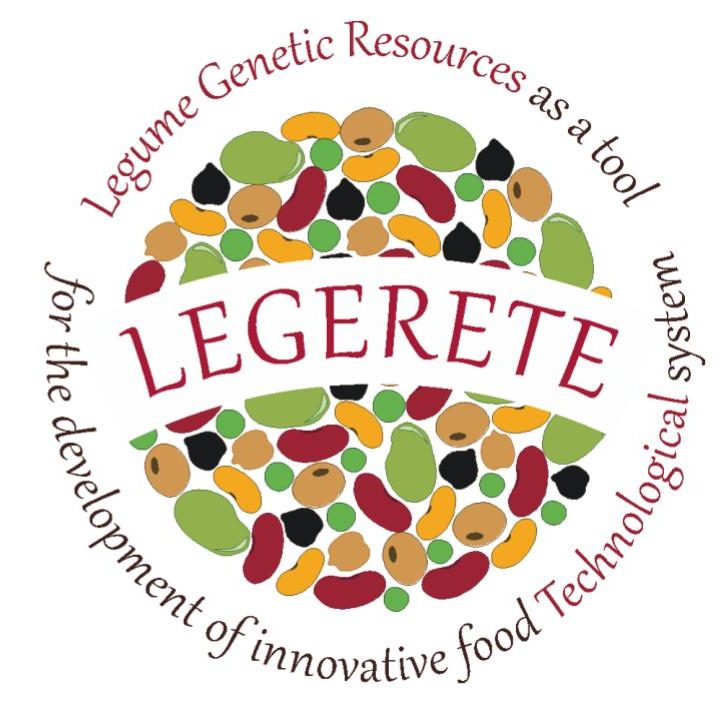Identification and valorization of genotypes with high agronomical, technological, and nutritional value
Evaluation of the selected genotypes for their potentially beneficial effects on human health


Development of innovative legume-based foods with high service value, able to induce the increase of legume consumption
Research of possible applications of legume flours and protein extracts as food ingredients or additives
In order to achieve the project end-results and to verify step by step the evolution of project activities, for each work package and task, Outcomes (OC) and Outputs (OP) have been clearly defined
Work packages
Work packages contents
Management and coordination project
The management team (MT) will be responsible to ensure the good performance of the project, in particular to reach the project goals, and to monitor the overall project quality and sustainability. In addition an Interdisciplinary Committee will be established to help monitoring the project. It will involve skills in literature (a literature professor expert in food literature and cultural solutions), geographical assessment (a professor in geographical sciences), social aspects (a consumers’ Association representative), law (a lawyer), and mass marketing (a representative of retailers and a packaging expert). The MT will supervise all the proposed activities to ensure that these activities will be performed in accordance with the conditions imposed by objectives, timing, and budget of the project. Specific outputs of the coordination WP will be the following:
OP1: Set up of a Project Quality Plan (PQP)
OP2: Reports of the meetings between Interdisciplinary Committee and the partnership
OP2: Realization of periodic meetings and videoconferences
OP3: Set up of specific documentation (checklist) to verify the project status, the partial and final objectives achievement, the congruence of results with the expected from the proposed program, and finally to draw up the project deliverables.
Set-up and genetic analysis of the project core collection
Task 1.1
Selection of legume germplasm based on basic agronomic traits, morphologic diversity and suitability to low-input farming systems
OC1: Characterization of the germplasm collection for suitability to low-input farming systems
OC2: Basic agronomic characterizations of the whole germplasm collection
OP1: List of at least 300 legume accessions for DNA analysis
Task 1.2
Set-up of the project core collection
OC1: Characterization of patterns of genetic diversity in legume germplasm
OP1: Report about the characterization of chickpea, lentil, faba bean and pea accessions by SNP and SSR markers (at least 3000 loci)
OP2: Report listing the accessions belonging to the project “core collection” (at least 200 legume accessions)
Task 1.3
In-depth agronomic characterization of the core collection and association mapping for the identification of genomic regions controlling agronomic, biochemical, nutritional and technological traits
OC1: Phenotypic characterization of the germplasm collection, useful for the identification of valuable genotypes
OC2: Characterization of the core collection for complex agronomic traits
OC3: Characterization of a panel of selected accessions in relation to climate change stresses
OP1: Report about the complete characterization of the core collection for complex agronomic traits
OP1: Selection of the accessions providing the best agronomic performance in low-input farming systems (at least one for each of the four legume species)
OP2: Detection of markers linked to loci controlling traits of agronomic interest (at least 5 traits).
Identification of valuable legume accessions characterized by high nutritional and technological value
Task 2.1
Chemical and nutritional characterization of the selected legume accessions
OC1: Set up of analytical protocols for the evaluation of the chemical and nutritional parameters
OP1: Chemical and nutritional characterization of 200 legume accessions
Task 2.2
Assessment of the functional properties of both the whole flours and protein extracts from the selected legume accessions
OC1: Set up of a protocol for whole meal flour preparation and protein extraction
OC2: Analytical protocols for the evaluation of the physic-chemical and functional properties of the whole meal flours and protein extracts.
OP1: Report with tables about the technological characterization of 200 legume accessions
OP2: “LeGeRe-Card-Book”, a card-book in which, for each accession, the agronomical features and the nutritional and functional properties will be reported.
Assessment of the potential beneficial effect of the selected legume accessions by “in vitro” and "in vivo" approaches
Task 3.1
In vitro evaluation of the anti-oxidant and anti-inflammatory effects of selected legume water extracts in a human hepatocyte cell line
OC1: In vitro assessment of the functional effects of the selected legume accessions
OP1: In vitro characterization of the potential beneficial effect on human health
Task 3.2
Evaluation of the selected legume accessions in a murine model of Non-Alcoholic Fatty Liver Disease (NAFLD)
OC1: In vivo assessment of the beneficial activity of the selected legume accession/s
OP1: In vivo characterization of the nutraceutical activity of the legume accessions object of the study
Task 4.1
Experimental trials for the formulation of innovative legume-based foods (legume-based vegetable burgers and sauces)
OC1: Set up of the technological productive process of legume-based foods
OP1: Production of the “LeGeRe” burger and of the “LeGeRe” Sauce (having the acronym “LeGeRe” a sound that in Italian recalls the word meaning “Light”).
Task 4.2
Experimental trials for the use of legume flours and protein extracts as food ingredients or additives
OC1: Set up of the technological productive process of foods obtained by using the flours and/or the protein extracts of the selected legume accessions as ingredients or additives.
OP1: Production of least two food products belonging to two different categories (one vegetable-based and the other meat-based) obtained by using, as ingredients or additives, the flours and/or the protein extracts of the selected legume accessions.
OC2: Shelf life assessment of the innovative food produced
OC3:Characterization of the innovative legume-based food from a nutritional, textural, and sensorial point of view
Economic and Environmental Sustainability assessment for semi-industrial scale up
Task 5.1
The Life Cycle Assessment approach
OP1: Evaluation of the environmental impact of the different solutions (at least three cases).
OP2: Evaluation of the environmental impact between innovative legume foods and traditional one.
OP3: Proposal of plants for a scale up phase.
Task 5.2
Study of the consumer attitudes towards innovative legume-based products and cowpea derived foods and evaluation of acceptance of innovation by consumers
OP1: Evaluation of consumer attitudes and consumer preference related to innovative legume-based products and to one cowpea-derived food product (“Atta”, a fried product -- As a consequence of the integration with ICOWpea Project).
Educational activities and dissemination of results
Educational and dissemination activities will be performed in close collaboration with the no-profit consortium “Consorzio Puglia Natura”, that is a new partner of the project and becomes responsible on the WP6.
OP1: Evidences of national and international exhibitions (letters of participation to the events, print or photocopies of the material presented to the events, list of stakeholders and other insiders interested to the topics of the project).
OP2: Web site and social network set up
OP3: Scientific publications and communications
OP4: Demonstration days
OP5: International final event
